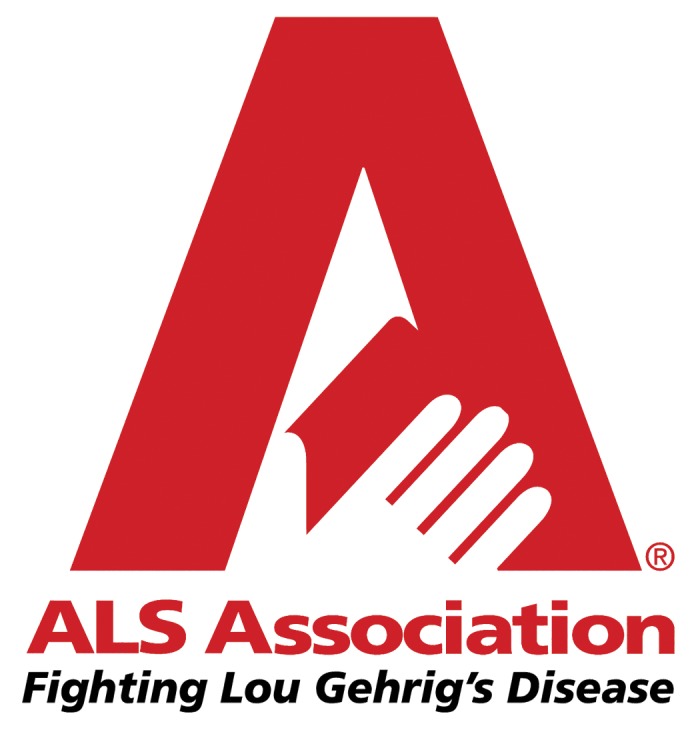Since 1985, The ALS Association has worked with people and their families living with amyotrophic lateral sclerosis (ALS) (Fig. 1). ALS, which is also known as Lou Gehrig disease, is a progressive neurodegenerative disease that affects the nerve cells in the brain and the spinal cord. The disease robs people of the ability to walk, to talk and even blink an eye. It traps them inside a body they no longer can control and ultimately prevents them from breathing as it takes their life.

Figure 1. ALS Association logo.
An estimated 5,600 Americans are diagnosed with the disease annually, and around 30,000 people in the US have ALS. Those with Lou Gehrig disease usually live two to five years following diagnosis. There is no known cause of the disease, although military veterans are approximately twice as likely to develop ALS as the general population for reasons unknown. There is no cure and no life-prolonging treatments for ALS at this time. Approximately 90 percent of people with ALS have the sporadic, or erratic, type of the disease, whereas 10 percent have the familial (inherited) form of ALS.
Care Services
The mission of the ALS Association is to lead the fight to treat and cure ALS through global research and nationwide advocacy while also empowering people with ALS and their families to live fuller lives by providing them with compassionate care and support. Care and support comes through our organization’s 38 chapters.1 Many of these chapters provide ALS families with various resources through our Care Services programs. Resources can include support groups, equipment loan closets, respite care and physician referrals—all provided at no cost. Many of these chapters also work closely with ALS Association Certified Centers2 and Clinics3 that offer specialized care to people with the disease.
Additionally, the Association invites its constituents to monthly care services and research webinars. Topics range from using assistive technology for communication4 to feeding tubes and nutrition5 to telemedicine for people with ALS.6
Global Research
Our Research Department’s partnership with the Northeast ALS Consortium (NEALS)7 supports a clinical trials network that enables the training of clinicians, the standardization of techniques, clinical and research webinars, a centralized database for ALS clinical trials and an expert who advises people with Lou Gehrig disease on clinical trials. We have also collaborated with other ALS organizations such as The Robert Packard Center for ALS Research at Johns Hopkins, Muscular Dystrophy Association, ALS Therapy Alliance and the National Institute of Neurological Disorders and Stroke (NINDS). These collaborations have yielded the development of animal model systems8 to expand knowledge about the most common cause of inherited ALS and Frontotemporal dementia (FTD), the C9ORF72 gene, and the funding of a trial involving use of a diaphragm pacing system9 that may allow people with ALS to breathe easier.
Aside from these research endeavors, our main research program Translational Research Advancing Therapies (TREAT ALS™) funds a diverse portfolio of ALS studies at leading institutions internationally. This program presently supports 90 active projects totaling $90 million. Current projects10 include the study of biomarkers, which serve as indicators of a specific biological condition, and the use of a “virtual” ALS Center that may provide remote care to people with ALS in their own homes.
Public Policy
Our Advocacy and Public Policy Department interacts with government agencies and Members of Congress to seek funding to find the causes, treatments and ultimately a cure for Lou Gehrig disease. Our work with these groups and ALS advocates across the country has produced more than $750 million in government funding for ALS research since The Association established this department in 1998. Much of this results from our constituents who visit Washington, DC each May for the National ALS Advocacy Day and Public Policy Conference.11 This year’s conference, which takes place May 8–11, will welcome around a thousand people with Lou Gehrig disease, their family members and others from the ALS community who will visit Capitol Hill to meet and share their ALS stories with their representatives. During these meetings, attendees will advocate for policies specifically designed to hasten the development of treatments for this disease.
We hope the combined voices of the conference’s participants will help bring us closer to achieving our vision: to create a world without ALS.
To learn more about The ALS Association, visit www.alsa.org.
References
- 1.The ALS association. In your community (Chapters) [internet] Washington, DC 20005 [cited 2013 April 25]. Available from: http://www.alsa.org/community/services.html?service_type=chapters&state=–Select+State–
- 2.The ALS association. In your community (Centers) [internet] Washington, DC 20005 [cited 2013 April 25]. Available from: http://www.alsa.org/community/services.html?service_type=centers&state=–Select+State–
- 3.The ALS association. In your community (Clinics) [internet] Washington, DC 20005 [cited 2013 April 25]. Available from: http://www.alsa.org/community/services.html?service_type=clinics&state=–Select+State–
- 4.The ALS association internet :Webinar AT. iPad Technology for Communication, Fun and Entertainment. Presenter: Alisa Brownlee [cited 2013 April 25]. Available from: http://web.alsa.org/site/DocServer/at_Webinar.pdf?docID=101781
- 5.The ALS association internet :Webinar AT. Adequate Nutrition and Feeding Tubes in ALS. Presenter: Heather K. Stoessel [cited 2013 April 25]. Available from: http://web.alsa.org/site/DocServer/Adequate_Nutrition_and_Feeding_Tubes_Webinar_in_ALS_Mar2.pdf?docID=101402
- 6.The ALS association internet :Webinar AT. Telemedicine May Offer ALS Patients Multidisciplinary Care in Their Own Homes. Presenter: James Berry [cited 2013 April 25]. Available from: http://web.alsa.org/site/DocServer/Berry_Telemedicine_Webinar_032613.pdf?docID=100921
- 7.NEALS: Northeast Amyotropic Lateral Sclerosis Consortium. [internet] [cited on 2013 April 25]. Available from http://www.alsconsortium.org/
- 8.The ALS association [internet]: The ALS Association and the Packard Center Partner to Develop Animal Model Systems for Most Common Cause of Familial ALS. (Published on 2012 March 1) [cited 2013 April 25]. Available from: http://www.alsa.org/news/media/press-releases/c9orf72-animal-model.html
- 9.The ALS association [internet]: Muscular Dystrophy Association and The ALS Association Fund Clinical Trial of Diaphragm Pacing System for People with ALS. (Published on 2012 March 1) [cited 2013 April 25]. Available from: http://www.alsa.org/news/media/press-releases/diaphragm-pacing-trial.html
- 10.The ALS association [internet]: ALS Association TREAT ALS™ Portfolio to Fund Ten New Awards Focusing on ALS Therapies. (Published on 2012 November 30) [cited 2013 April 25]. Available from: http://www.alsa.org/news/archive/als-association-treat-als.html
- 11.The ALS association [internet]: National ALS advocacy and public policy conference [cited 2013 April 25]. Available from: http://www.alsa.org/advocacy/advocacy-day/


